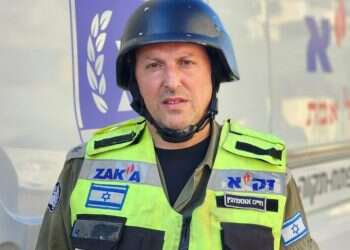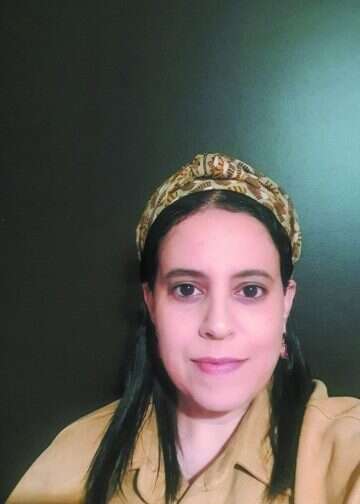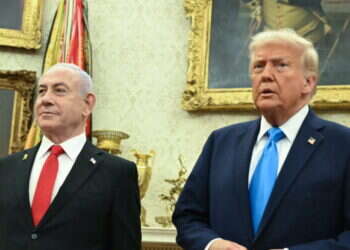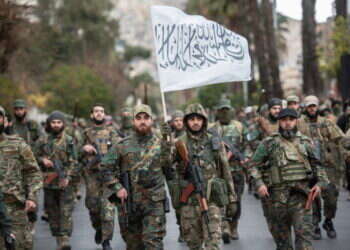Although highly descriptive details have been omitted from the following article, it may still be distressing or triggering for some individuals.
Reader discretion is advised, and if you find such material upsetting, it may be advisable to consider not engaging with the content.
Translated by Ruchie Avital
Interrogator: What did they want to do with them? [With the female hostages]
Terrorist: To defile them.
Interrogator: What does that mean “to defile them?”
[The terrorist hesitates]
Interrogator: Talk!
Terrorist: I don’t want to talk!
Interrogator: Talk, talk, it’s between us. What did they want to do with them?
Terrorist: To defile them, you know, to rape them.
Interrogator: And why did they take children and babies?
Terrorist: To rape them.
(Video documentation of the interrogation of a Hamas terrorist)
The October 7 massacre perpetrated by Hamas terrorists was marked by unspeakable acts of violence in terms of their brutality and scale: Innocents of all ages, including elderly men, women, children and babies were burned alive, dismembered and taken hostage. Additionally, acts of rape and extreme sexual and gender violence occurred.
When addressing the sexual crimes committed by these despicable terrorists – some that we are starting to hear about and some that we may never hear about – the question arises as to whether these heinous sexual crimes were planned deliberately or if the attack “spiraled out of control.” Defense Minister Yoav Galant has revealed to the international media in recent weeks that the captured terrorists' interrogations coupled with intelligence gathered inside Israel indicate that one of the raid's specific objectives was to commit rape and mutilate the victims' bodies. In other words, these acts of rape and other atrocities were planned and executed with deliberate intent and careful instructions.
Racial and gender-based violence have always been closely intertwined. Throughout history, women have suffered from injury and sexual assault during times of war, not only because of their gender, but also due to their specific nationality. In fact, women face a twofold danger during times of conflict because they are targeted both as members of the enemy nation and as women. Sexual crimes and rape are often employed as tools to achieve military and war objectives. Women are not only seen as sexual objects, but also as symbols of the nationality under assault. These sexual crimes have a clear objective: to degrade, humiliate and even annihilate the targeted ethnic group or nationality. Accordingly, the conventional terms used to describe and explain “normal” sexual violence are inadequate when addressing sexual violence during wartime, and may even obscure its nuanced nature.
Dr. Naomi Halbert-Landau, a lecturer at the Ono Academic College, wrote her doctoral dissertation on the intersection of sexual violence and genocide. As part of her study, she conducted interviews in 2018 with Yazidi women and girls who had been captured and subjected to sexual abuse by ISIS soldiers and later found refuge in Germany, and took part in a therapeutic project. She draws attention to the striking similarities between the Yazidi genocide and the massacre in the Israeli communities near Gaza. She refrains from explicitly using the term “genocide,” and instead, chooses to describe it as “an event that echoes the atrocities of genocide.” According to her, “To assert that the objective is to ‘defile the women' is truly a statement drawn from the realms of genocide.”
“It’s essentially a genocide that didn’t succeed,” she explains.” If not for the intervention of the Israeli army and fighters who halted the massacre, the horrific events would have spread and reached other places in Israel. We know that this was their plan. They had no intention of stopping. The objectives, operational premises and patterns of behavior are indicative of an intent to abuse and harm a civilian population, far beyond the “ordinary terrorism” with which, unfortunately, we have become all too familiar. The terrorists roamed around some of the kibbutzim for hours and their aim was not just to kill and move on. Their aim was to “kill, slaughter and annihilate.”
Dr. Halbert-Landau highlights gang rape as the first characteristic in this context. Last week, the police took a witness testimony involving the gang rape and murder of a young woman on October 7.
“We have the testimony of a girl who was in Re’im, where the rave party was held, and witnessed such a rape. She sat across from a police investigator and recounted what she saw,” says Deputy Inspector Moshe Pinchi, head of the police Media Relations Department. “The witness described the victim being passed from one man to another and subjected to rape and abuse.”
“Gang rape is a common occurrence in situations of genocide,” explains Dr. Halberthal-Landau. “It’s a practice that further heightens the humiliation and fosters a kind of warped camaraderie among the fighters. It’s different from what might be called ‘rape during normal or peaceful times’ when the rape victim is usually assaulted in much more private conditions. Here, a crowd gathers around the unfortunate woman.”
Another similar element is the abuse. “This includes acts of unimaginable savagery, public rape, rape in the presence of the spouse and or children, which is accompanied by the element of humiliation. A third part is the abuse and mutilation of the female body – a pregnant woman’s belly was sliced open and women’s bodies were abused and desecrated. Once again, these are exactly the same realms of barbaric and murderous behavior that occur during genocide.
A recurring pattern

Currently, a nationwide inquiry is underway to investigate all aspects of the October 7 massacre, involving multiple teams, including the Israel Security Agency (ISA), the police, the prosecutor’s office and the Israel Defense Forces (IDF), all operating under the oversight of the Attorney General’s office. “The primary objective of the teams of Israel Police's Lahav 433 unit, the national crime investigation unit, is to meticulously document and gather digital and forensic evidence of the heinous crimes committed by the perpetrators,” says Deputy Inspector Pinchi, “just as Nazi crimes were documented for the preservation of Israel’s history.”
According to Pinchi, “Lahav 433 has already amassed about a thousand testimonies related to the massacre thus far from various sources, including interrogations of captured terrorists, surviving victims, eyewitnesses or from the testimonies of the volunteer ZAKA personnel that arrived on the scene to recover the bodies. Disturbingly, numerous testimonies and pieces of evidence point to sexual crimes, including the amputation and mutilation of body parts and brutal rape. Testimonies from ZAKA personnel describe charred bodies with missing parts to the extent that it was not always possible to determine whether it was a man or a woman. Additionally, there are testimonies and images depicting actions that occurred in the area of the rave party involving women with torn clothing.”
Chaim Otmazgin, the commander of the special ZAKA units, recovered the bodies of two women and a man who were shot at close range. “They were part of a group of people who had fled from the party to an orchard nearby. When I was asked to testify about this specific event, I only understood in retrospect things that I was unable to fully interpret at the time. The entire top part of one of the women’s garments was torn off. It’s not like she went to the rave with a torn top, or that the garment was torn while she was running away. This was a deliberately aggressive action towards the woman’s upper body.
The police are not yet discussing the scope of the crimes because the investigation is ongoing and the state prosecution has decided not to address the issue of sex crimes at this stage. Although Otmazgin prefers not to speak specifically about the sexual abuse, he points to a recurring pattern.
“There were naked women separated from the other family members,” he says. “If the volunteers found a woman in the protected room and in a room across the hall, they find a young girl with her trousers pulled down, we understand that it’s not because went to her room to change her clothes. Inside the kibbutzim, in some houses, girls were found separated from the rest of the family, and naked men were found tied up separately from the family members. The assumption is that they were sexually assaulted. I can’t think of any other reason.”
Regarding the scope of the phenomenon, Otmazgin says, “There aren't any numbers, there is nothing empirical. But I can speak from my impressions as the person who coordinated the efforts. I hear a story from one volunteer, and then I hear stories from other volunteers who describe exactly the same thing, and from this, I can see that there is a clear pattern of behavior, and whoever had the ability to do it did it. We are aware of at least 15 cases of women and men who were separated from their families and found in a separate room from them.”
In a video testimony in English distributed by the Prime Minister's spokesperson to foreign media, a paramedic, with his back to the camera, described what he saw with his own eyes in a house in one of the kibbutzim in the Gaza periphery while the security forces were still fighting in the area. “I see two girls lying down, one on a bed, one on the floor. The one on the floor is lying on her stomach. Her pants are pulled down and she is half naked. Someone executed her right after he raped her, he shot her in the head, leaving her lying in her own blood. That was the first time that I got, you know, a slap in the face, when I realized that we are not just dealing with terrorists here. We are waging a war against savages, inhuman savages.”
At this time, there are no testimonies about rape in the first person. The assumption is that those who were sexually assaulted are mostly no longer alive, and even if there are a few who survived the horror, it is doubtful whether they will ever be able or want to speak about what happened to them.
Chaim Otmazgin, ZAKA: “From the way we found some of the bodies, we can piece together the story behind them. Even now, the images continue to race through my thoughts and I can’t believe that what I saw is what I saw, but that is the reality.”
“Digesting trauma of this kind is at the extreme pole of the trauma graph,” says Orit Soliciano, CEO of the Association of Rape Crisis Centers. “Some of the victims in the kibbutzim also need to deal with the trauma of murdered family members and friends, at a time when they are also being evacuated from their homes. They first need to regain a basic sense of control over their lives. They need a home, a moment to breathe, to walk the dog. Those who attended the rave party, who don’t belong to a community, find solace in being together, and even their parents may not know exactly what happened to them. We are still only at the very beginning. After the Holocaust, it took decades for people to talk about the atrocities, and only in the last decade have they started to talk about the sexual abuse.”
Like the Eichmann trial
In the last week, claims have begun to be heard about an “evidence failure” in regard to the documentation and collection of findings from the field and the photographing of the bodies, which might eventually create a difficulty in bringing the terrorists to justice in international courts for war crimes and crimes against humanity.
Deputy Commander Pinchi explains that this is not a conventional investigation.

“The difficulty in investigating this event lies in the scale of the murders, the scale of the crimes and the large number of terrorists that participated in the events. This is the first time the police are investigating crimes committed during a war, in a war zone, in the midst of a war that is not yet over. Normally, it takes about half a day to document a crime scene. Here, we’re talking about the scene of a mass slaughter, which at some point the armed forces arrived at and fought in. It took some time until they were able to clear the area of terrorists, and then it was declared a restricted military zone, and volunteers entered to recover the bodies.”
In legal terms, he notes, “There are about 3,000 murderers-terrorists who are linked to all the acts that were perpetrated. It will be difficult to prove that terrorist X murdered a specific individual. If we are talking about rape, we can’t look for a specific person’s semen and tie it to a specific body. All the terrorists were wearing green headbands, it’s almost impossible to distinguish among them and they themselves admit that they came to murder, burn, slaughter and rape. So, it doesn't matter what a specific terrorist did; each one will be accused of all 1,400 murders. This is not a normal gathering of evidence but something resembling the nature of the Eichmann trial.”
Denials of the atrocities began to be aired on social and world media just a few days after October 7. “Provide evidence!” shouted Hamas supporters and pro-Palestinian activists. Smooth-talking speakers sat in air-conditioned studios and brazenly denied the atrocities, while various and sundry conspiracy theories, including claims that the State of Israel was behind the events, were circulated online. Singer Roger Waters, a longtime supporter of the BDS movement against Israel, said that the events were “thrown all out of proportion by Israelis making up stories about beheading babies.” Even here in Israel, Knesset Member Iman Khatib-Yassin from the United Arab List Ra'am party denied that babies were slaughtered and women were raped in the massacre. She later apologized.
The difficulties in obtaining evidence from the charred scenes play into the hands of those who would deny the events of that horrific day. “Even if a CNN cameraman had arrived straight on the scene, he would not have been able to videotape a rape or get an image of the incident immediately after the rape. It’s impossible,” explains Otmazgin. “A woman who has been raped and then shot won’t be found fifteen minutes later in the position she was in when she was raped. She will have tried to defend herself, to flee, the position of the body changes, contracts, relaxes. It’s a process that takes several hours. Anyone capable of causing harm and abuse did so.
“We have extensive experience at crimes scenes and those of terror attacks. Our routine is made up of crime scenes, murder scenes and accident and disaster scenes. We have a keen eye for measuring the silence in a room. From the way we found some of the bodies, we can piece together the story behind them. The mind cannot take it in. Even now, the images continue to race through my thoughts and I can’t believe that I saw what I saw, but that is the reality. If there is anyone who dares to accuse a ZAKA volunteer of lying, I challenge him to look me in the eye and say that even one iota of our account is untrue.
“Professionals who deal with wartime sexual offenses use the term ‘reversing the burden of proof,’ and we are starting to use it too,” says Soliciano. “They do not rely solely on forensic evidence but work from the assumption that the acts occurred. Atrocities and sadism are integral to Hamas's practices, and that is how we approach the subject.”
Thunderous silence
The deafening silence from women's organizations in the world in the face of the horrific sexual violence of the Hamas terrorists is as outrageous as it is astonishing. However, the UN Women's Organization outdid them all: Since the seventh of October, the organization has published several reports and articles on the situation of women in Gaza. Not a single word was included in any of them about the horrors that Israel's women, girls and children experienced, and there was no call for the release of the hostages or for intervention by the Red Cross.

Meital Bonchek, VP at the Briah Foundation (Keren Briah), which promotes women’s rights in healthcare, signed on behalf of her organization, along with dozens of other women's organizations in Israel, “several public letters addressed to these organizations demanding that they break their silence against gender crimes committed by Hamas, but they persist in their silence,” she says.
“Most outrageously, the UN Women's Organization published a comprehensive report on October 13 about what is happening in 'Occupied Palestine,' but ignored the atrocities committed against Israeli women on October 7, did not call for the release of our hostages and avoided putting pressure on the Red Cross to act on their behalf, despite their obvious medical needs in the context of pregnancy, childbirth, breast cancer, infections and more.
“A deliberate effort was made, possibly driven by underlying antisemitic sentiments, to construct a narrative that highlights the experiences of Palestinian women while disregarding the gender-based violence inflicted on Israeli women, as well as the atrocities that were deliberately planned and executed according to the testimony of the terrorists themselves. They labeled the massacre the ‘conflict in Gaza' and refrained from framing Hamas as a terrorist organization. The UN Women’s Organization is thwarting its own goals by using a practice that silences war crimes, thereby rendering the entire system of international law superfluous. It’s a deplorable disgrace for an institution that should be a beacon of justice.”
Orit Soliciano, CEO of the Association of Rape Crisis Centers. “We are still at the very beginning. After the Holocaust, it took decades for people to talk about the atrocities, and only in the last decade have they started to talk about sexual abuse.”
This week, Danielle Ofek and Nataly Livski launched a campaign under the hashtag #MeToo_UNless_UR_a_Jew. It is aimed at reminding the organization that claims to be a “global champion for gender equality” that “every woman's life is equally precious,” and condemns the UN’s silence regarding the plight of Israeli women. The objective is to collect a million signatures; as of the writing of these lines, over 220,000 have been collected.
What do we do now? How do we tend to the wounds? How can we, as a society that seeks life, create an environment that will allow the sexual trauma of our sisters and brothers to be treated properly, with the hope that they will find solace and healing? How should the health system prepare itself to treat victims?
“Sexual violence in war causes distinct physical harm, but also profound trauma that can lead to increasing functional damage if not treated,” says Bonchek. “One of the barriers to receiving treatment is feelings of shame and a desire to hide the ordeal and avoid stigmatization. This is one of the reasons that at this stage we do not yet have first-person testimonies of women who have been harmed. The civil spheres and the medical community must show responsibility and provide support to women in various circles of care, create a safe space for the woman, and of course emphasize that it’s not her fault and encourage her to receive treatment as quickly as possible. The absence of this kind of intervention puts the woman at risk of a host of mental and physical disorders, including suicide.”
It is possible, says Bonchek, that there are injured women or survivors among us who were severely sexually assaulted and are afraid to talk about it in either the private or public sphere. “The medical teams in the various disciplines need to be trained to identify victims of sexual assault and provide trauma care for them. These tools will facilitate beneficial professional treatment, so that victims aren't forced to relive the trauma as a result of a lack of awareness on the part of caregivers of the various triggers that may overwhelm the women who have been affected. The initial questions must be sensitive. The College of Family Physicians of Canada suggests an open question that allows victims to answer indirectly: ‘We have received reports that many of the injured women experienced sexual violence, injury or assault. Did this happen to you too?’ This is a critical query. Early treatment can prevent future complications.
“The World Health Organization provided training to medical teams in Ukraine, and we can learn from the model developed there. The training focused on identifying victims of sexual assault, delivering medical and psychological care and providing knowledge about support resources and rights in the community. In Ukraine, 90% of the women who experienced sexual assault did not report it, but if they needed medical treatment as a result, they sought it out. If the situation here is comparable, it may be inferred that the medical teams are at the forefront of identifying and providing support to these women. It’s also important to provide support to the medical teams that are exposed to the shocking descriptions, because they may experience secondary trauma as well as what is known as ‘compassion fatigue.’”
Soliciano comments on another point: “When the hostages come home, they should not be asked if they were sexually assaulted. Our guiding principle is the victim's need to regain control over her life after control over her body was taken from her. This is fundamental to the healing process. We never ask anything. We need to allow the woman to talk about what she wants to talk about. No pressure whatsoever to talk should be exerted on the hostages that come home. I am very concerned that this may be exactly what might happen, that the media will pounce on them. A trauma-aware spokesperson who is also media savvy should be appointed to manage the representation of the hostages during this period. No one should directly contact any of the hostages or their families in order to inquire about whether or not they experienced sexual assault.”
She also warns against adopting the discourse of the enemy and the psychological warfare that it engages in. “Hamas characterizes sexual assault as ‘defiling the woman,’ using the woman as a symbol of the state and the nation. They harm her to harm the state. So, not only did something horrific happen, now the state wants to obtain the evidence, but not because of the suffering of the individual woman, but to use it for Israeli advocacy. We must look at the victim and ask, ‘What about her dignity and privacy?’ I want people to know about the war crimes, but we must first see each woman as an individual.”












